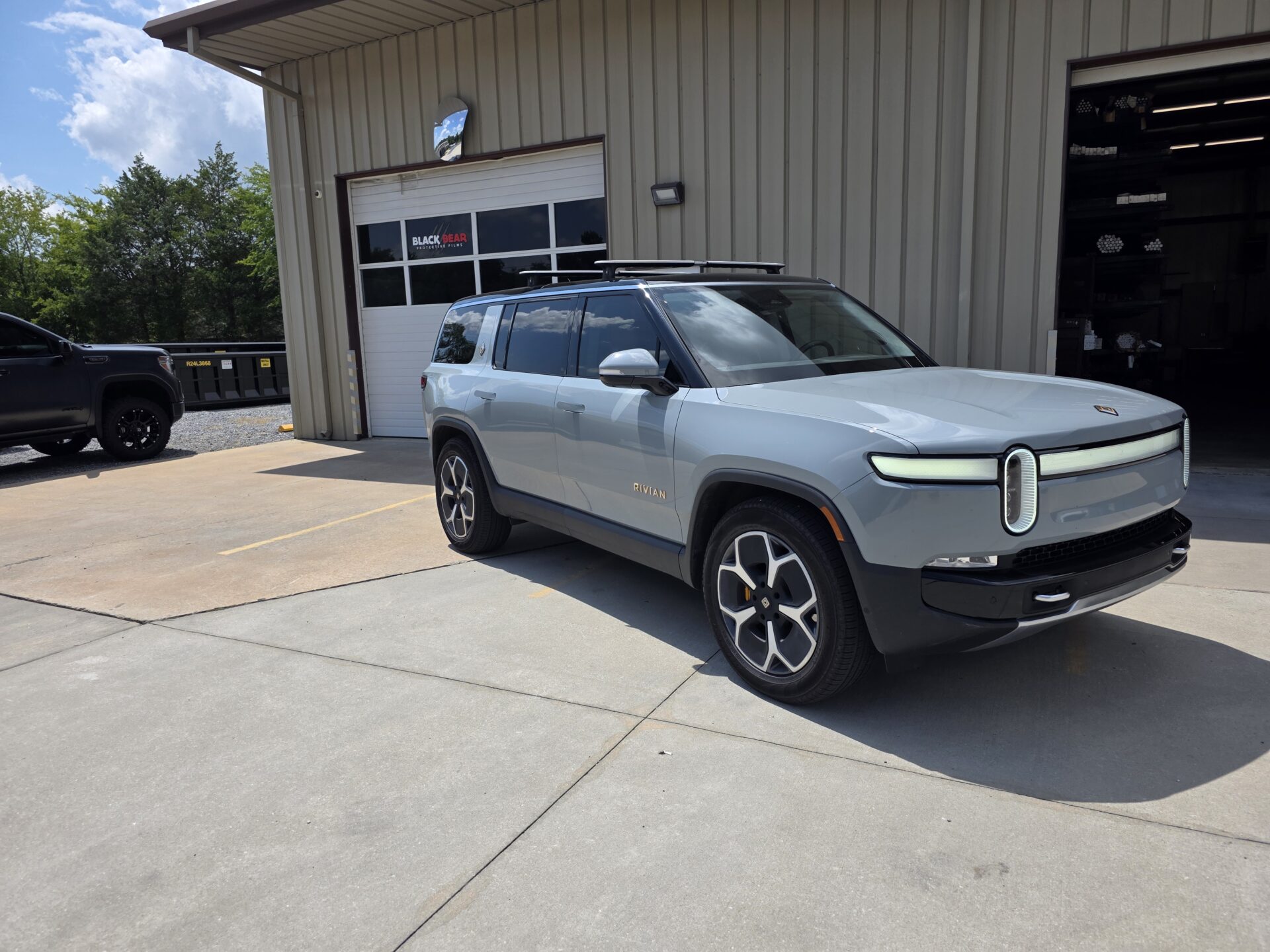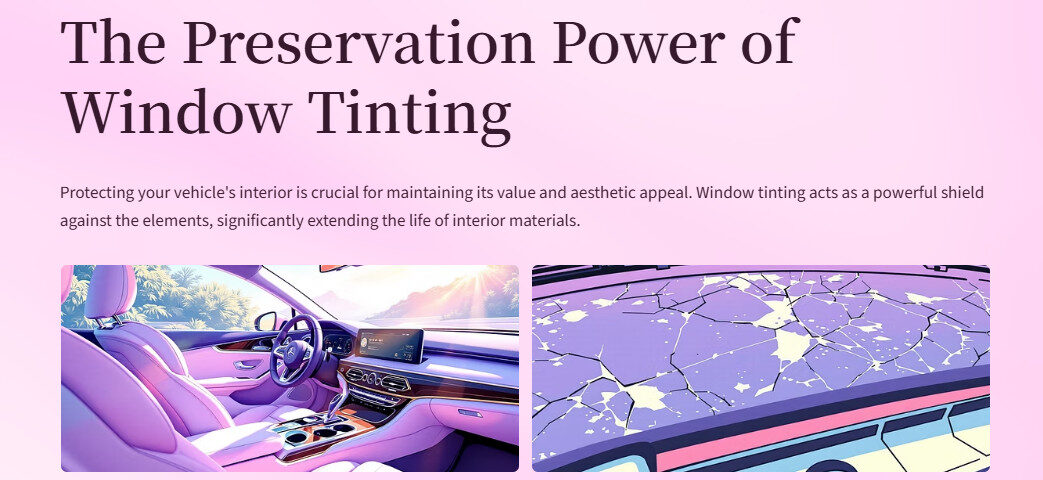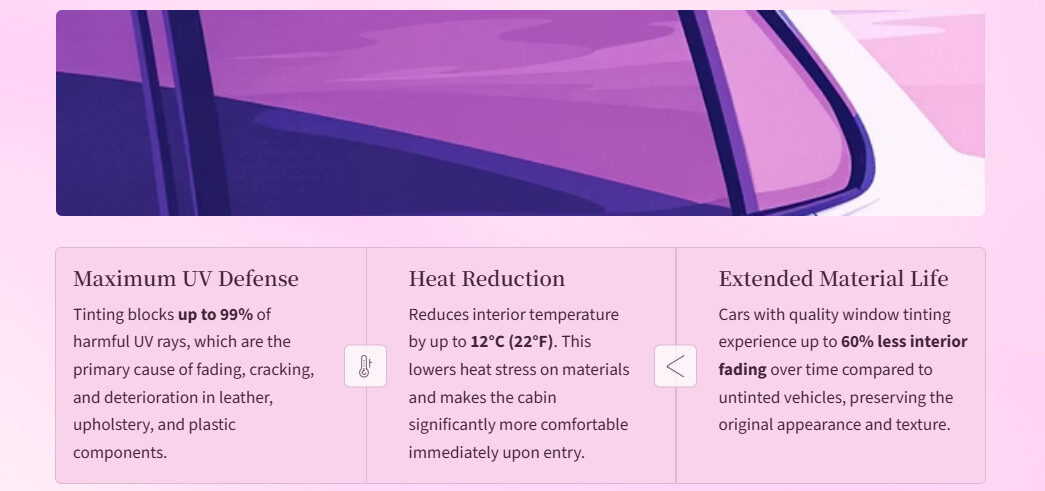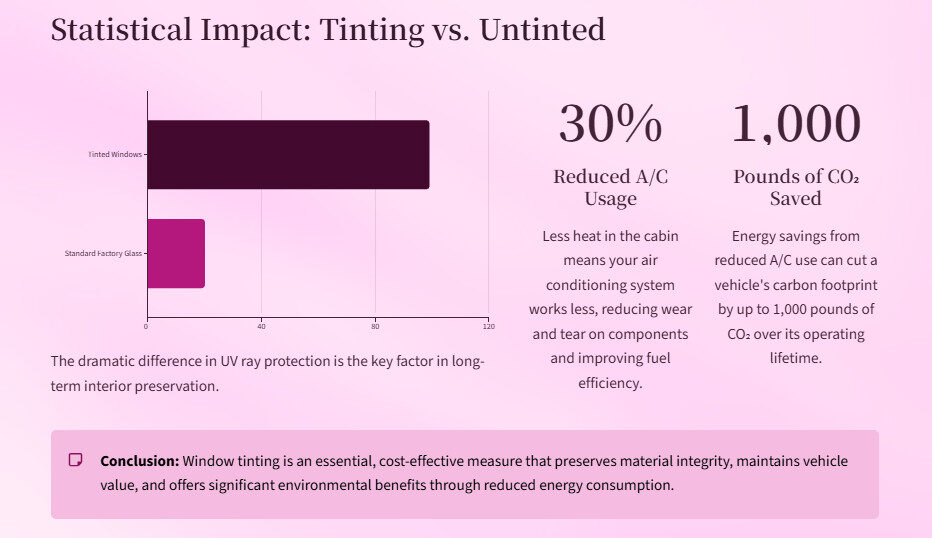Think of your vehicle’s interior like the skin of your body — constantly exposed to the elements, slowly wearing down with every drive under the sun. While cars are designed to handle outdoor conditions, their interiors are surprisingly vulnerable. Leather cracks, fabric fades, dashboards warp, and plastics weaken, all thanks to one powerful culprit: sunlight. Over years of use, these effects become impossible to ignore.
Window tinting provides one of the most effective ways to shield your vehicle’s interior from this steady attack. By limiting UV radiation, reducing heat, and stabilizing cabin conditions, tinting acts like sunscreen and insulation rolled into one. Companies like Black Bear Protective Films emphasize the importance of understanding how tinting is less about looks and more about long-term protection.
Why Interiors Deteriorate Over Time
Sunlight Exposure and UV Damage
Sunlight may seem harmless at first glance, but ultraviolet (UV) rays penetrate glass and directly affect interior materials. Fabrics lose their vibrant color, leather loses its oils and flexibility, and plastics gradually break down at the molecular level. Over time, this leads to faded upholstery and brittle textures.
Researchers have found that up to 40% of interior fading is caused by UV radiation alone. This makes sunlight the single largest factor in visible deterioration. Without protective barriers, interiors face relentless exposure that accelerates wear.
Heat Stress on Vehicle Materials
In hot climates, interiors don’t just face UV rays — they endure extreme heat. Cabin temperatures can exceed 120°F (49°C) within 30 minutes of sun exposure. This thermal stress causes expansion and contraction of materials.
Leather seats may shrink, dashboards warp, and adhesives lose their bond. Even small variations in daily heat cycles create microscopic cracks that eventually become visible damage. Tinting helps regulate these fluctuations, easing the stress on interior components.
The Science Behind Window Tinting
UV Ray Blocking Properties
High-quality window films are engineered to block up to 99% of harmful UV rays. By reducing the light spectrum that enters the cabin, tinting directly addresses the leading cause of fading.
This barrier not only extends the life of materials but also reduces health risks for passengers. After all, UV rays don’t just harm interiors — they also damage human skin.
Infrared Heat Rejection
While UV rays cause fading, infrared radiation is what makes interiors hot. Window Tinting Indian Land SC is designed with infrared-blocking technology that keeps heat from building up inside.
By lowering cabin heat, interiors remain under less thermal stress. Adhesives, stitching, and sensitive plastics maintain structural integrity for longer, preserving both function and aesthetics.

Protecting Upholstery and Fabrics
Preventing Fading in Cloth Interiors
Fabric seats and trims are highly susceptible to bleaching under sunlight. Reds, blues, and darker tones fade the fastest, leaving interiors looking worn. Window tinting acts as a shield, slowing down the bleaching process significantly.
This allows fabrics to retain their original vibrancy for years longer, maintaining both resale value and daily appeal.
Maintaining Leather Quality
Leather is durable but requires care to stay supple. Constant sun exposure drains natural oils, leaving leather dry and cracked. Once cracked, repairs are rarely perfect.
Tinting reduces exposure and helps leather maintain moisture balance. As a result, seats stay smooth, flexible, and comfortable — a benefit every driver can feel daily.
Safeguarding Dashboards and Plastic Components
Cracking, Warping, and Discoloration
Dashboards and plastic trims are among the most vulnerable parts of a car interior. They absorb both heat and UV radiation, which leads to cracking, fading, and even warping.
Tinted windows filter harmful rays before they reach these surfaces, ensuring longer-lasting dashboards and trim. This not only improves appearance but also maintains safety, since warped panels can interfere with airbag deployment.
Longevity of Electronic Systems
Modern cars come with digital displays, touchscreens, and sensors embedded in dashboards. These electronics are sensitive to heat, and prolonged exposure shortens their lifespan.
By keeping cabin temperatures lower, window tinting indirectly protects electronic components, extending their durability and reducing risks of failure.
Enhancing Comfort and Durability Together
Temperature Balance and Interior Life
When cabin conditions are stable, interior materials last longer. Fluctuations between extreme heat and cooler nights create stress on every surface. Window tinting reduces these swings, making conditions more balanced.
The result is not only a more comfortable driving experience but also a prolonged life for all interior components. Comfort and preservation work hand in hand.
Window Tinting as Preventive Care
Like regular oil changes or tire rotations, tinting should be seen as preventive maintenance. It doesn’t fix existing problems but prevents them from forming in the first place.
By lowering stress factors such as UV radiation and heat, tinting adds years of usable life to a vehicle’s interior. Preventive care is always more cost-effective than repair.
Scientific Studies on Tinting and Preservation
Laboratory Findings
Tests on window films show measurable reductions in fabric fading, leather degradation, and dashboard cracking. Controlled studies confirm that interiors exposed to tinted glass age more slowly than those exposed to untreated glass.
These findings highlight tinting as a scientifically supported method of interior preservation, not just a cosmetic upgrade.
Real-World Examples from Hot Regions
Drivers in regions like Arizona, Texas, and the Middle East report visible differences between tinted and non-tinted cars. Interiors with tinting maintain better condition after years of use, while untreated vehicles show severe fading and cracking.
This real-world evidence reinforces the laboratory data and shows tinting’s role in extending vehicle life.
Black Bear Protective Films and Educational Role
Highlighting Long-Term Preservation Benefits
Black Bear Protective Films provides resources that explain how tinting directly protects vehicle interiors. Their emphasis on UV and heat reduction highlights the connection between scientific studies and everyday driving conditions.
By framing tinting as protection rather than decoration, they contribute to a clearer understanding of why interiors last longer with films applied.
Supporting Awareness for Drivers
Beyond product development, their role in educating drivers is crucial. Many car owners underestimate how quickly interiors deteriorate without protection. By providing information, they help drivers make informed choices about preserving their vehicles.
Black Bear Protective Films Serving the Carmel Woods and Beyond in Charlotte North Carolina
Black Bear Protective Films is dedicated to serving the diverse needs of the local community of Charlotte North Carolina. Including individuals residing in neighborhood like Carmel Woods With its convenient location near landmarks such as the “Carmel Middle School, Carmel Road Park” major intersections like Laurium Road & Fern Grove Road and Carmel Road & Quail Hollow Road (near Carmel Road Park)”
(coordinates: 35.126770327570256, -80.7955446386306) We offer Window tinting services.
Get Window Tinting Services at Carmel Woods
Navigate from Carmel Woods to Black Bear Protective Films
How Window Tinting Helps Preserve Vehicle Interiors Over Time?
- Blocks up to 99% of harmful UV rays that cause fading, cracking, and deterioration of upholstery, leather, dashboards, and plastics.
- Reduces interior temperature by up to 12°C (22°F) compared to untinted vehicles, lowering heat stress on materials and improving comfort.
- Cars with window tinting experience up to 60% less interior fading over time versus untinted cars, extending the life and appearance of interiors.
- Decreases air conditioning use by ~30%, reducing wear on AC systems and improving fuel efficiency, indirectly preserving interior components.
- Studies show tinted vehicles can reduce their carbon footprint by up to 1,000 pounds of CO₂ over their lifetime due to energy savings.
Visual Chart Concepts (to be designed):
- Bar chart: UV Protection (%) — Untinted (~10-20%) vs. Tinted (up to 99%)
- Line graph: Interior Temperature (°F) over time — Untinted (80°F+) vs. Tinted (60-70°F)
- Pie chart: Percentage reduction in interior fading (60% less fading with tint)
- Infographic icon: AC usage reduction (30%) and CO₂ emissions saved (1,000 lbs)



Sources: Endless Detailing WI (2025), Grandview Research (2025), Tekshine (2025), Orozco’s Auto Detailing (2025)
Vehicle interiors are under constant attack from sunlight and heat. Without protection, fabrics fade, leather cracks, dashboards warp, and electronics fail sooner. Window tinting addresses these issues head-on by blocking UV rays, reducing heat, and stabilizing cabin conditions.
Thanks to scientific backing and real-world results, it’s clear that tinting is more than an aesthetic choice — it’s a practical tool for preserving interiors over time. Informational resources from Black Bear Protective Films further demonstrate how knowledge and prevention can help every driver protect their investment.
FAQs
Q1: How does window tinting prevent fading in car interiors?
Tinting blocks harmful UV rays that bleach fabrics and weaken materials, slowing down the fading process.
Q2: Does tinting protect leather seats from cracking?
Yes. By reducing sunlight and heat exposure, tinting helps leather maintain oils and flexibility.
Q3: Can window tinting extend the life of dashboards?
Absolutely. It reduces heat and UV exposure that cause cracking, warping, and discoloration.
Q4: Do electronic systems in cars benefit from tinting?
Yes. Lower cabin heat means less thermal stress on sensitive electronics like touchscreens and sensors.
Q5: Is window tinting mainly for appearance or protection?
While it changes appearance, the primary benefit is protection — prolonging the life and quality of vehicle interiors.
Our Other Blog Posts Related Window Tinting
The Science of Window Tinting: Demystifying VLT for Waxhaw, NC Drivers
How Window Tinting in Indian Land, SC Improves Driving Comfort in Hot Weather
Energy Savings with Window Tinting in Indian Land, SC for Electric Vehicles
How Window Tinting in Indian Land SC Protects Car Batteries and Electronics
Window Tinting Laws South Carolina | Legal Tint Limits Guide

